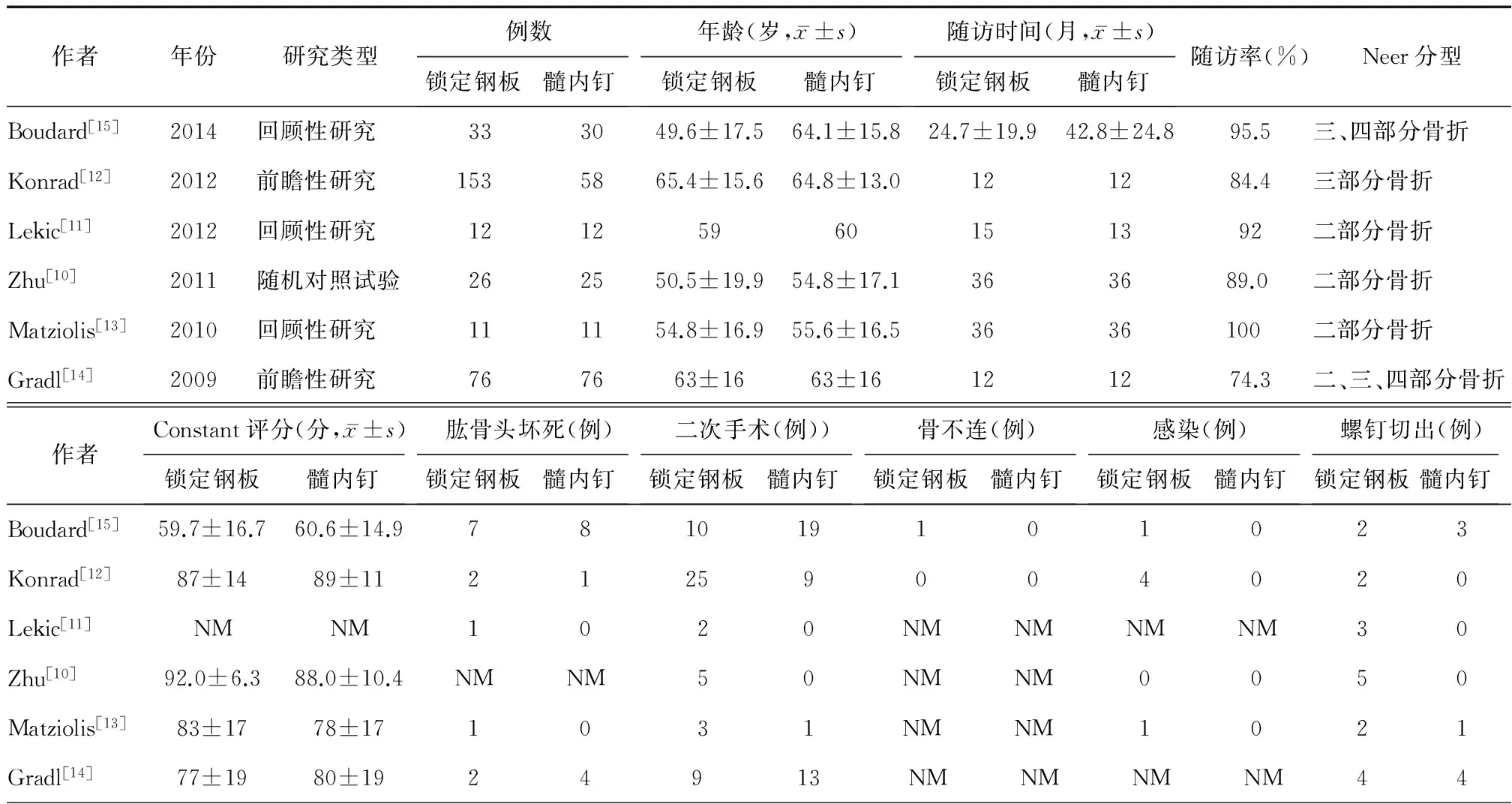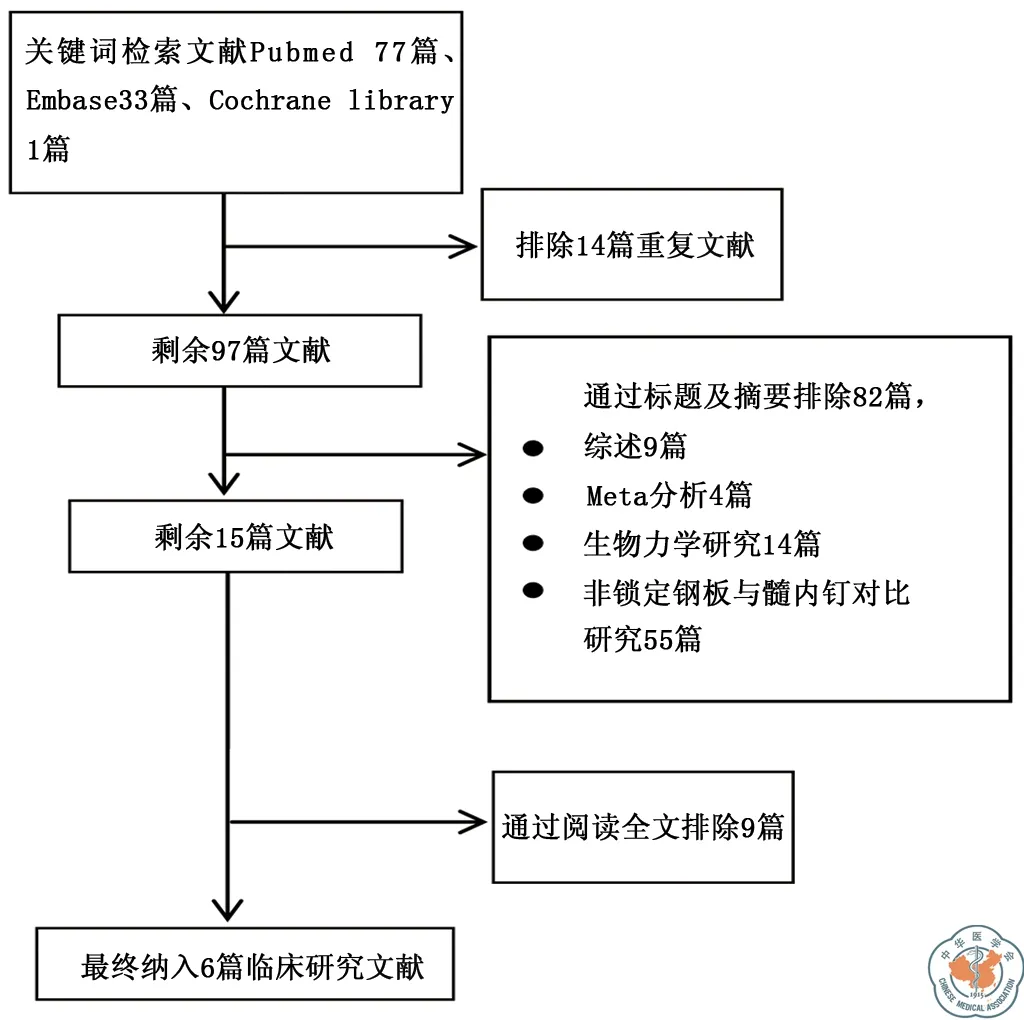锁定钢板与髓内钉治疗肱骨近端骨折疗效比较的Meta分析
张军 袁承杰 曹烈虎 陈晓 翁蔚宗 苏佳灿
·论著·
锁定钢板与髓内钉治疗肱骨近端骨折疗效比较的Meta分析
张军 袁承杰 曹烈虎 陈晓 翁蔚宗 苏佳灿
目的 评价锁定钢板与髓内钉治疗肱骨近端骨折的疗效差异。方法 用计算机在Pubmed、Embase、Cochrane library中检索,检索日期截止至2016年6月,收集关于锁定钢板、髓内钉治疗肱骨近端二部分、三部分、四部分骨折的临床研究,采用RevMan 5.2软件进行Meta分析。结果 纳入1篇随机对照研究,5篇回顾性研究,共涉及523例患者,其中锁定钢板组311例,髓内钉组212例。采用Constant肩关节功能评分,两组内固定方式结果相似[MD=-0.29,95%CI(-2.71~2.13),P=0.82]。在肱骨头坏死、术后感染和螺钉切出等并发症方面,两种内固定方式差异无统计学意义。结论 锁定钢板与髓内钉治疗肱骨近端骨折临床效果相似,术后并发症差异无统计学意义,仍需要多中心、随机对照试验评估锁定钢板、髓内钉治疗肱骨近端骨折的临床疗效。
肱骨近端骨折;锁定钢板;髓内钉;Meta分析
肱骨近端骨折占全身骨折的6%[1],除髋部骨折、桡骨远端骨折外,肱骨近端骨折为老年患者中第三大常见骨折[2]。其中大部分肱骨近端骨折可通过保守治疗,早期肩肘吊带固定,后期加强患肢康复锻炼。然而,对于移位、不稳定肱骨近端骨折,为获得满意的功能结果,往往需要手术治疗[3]。据统计,该类骨折占所有肱骨近端骨折类型的12.6%[4]。
目前,肱骨近端骨折手术治疗方法较多,如肱骨近端锁定钢板、髓内钉、半肩关节置换及反肩关节置换等[5-6]。然而,治疗肱骨近端二、三、四部分骨折的最佳方式是锁定钢板还是髓内钉,目前仍存在争议。笔者通过对锁定钢板和髓内钉治疗肱骨近端骨折的临床研究进行Meta分析,为肱骨近端骨折的治疗提供理论依据。
资 料 与 方 法
一、 纳入与排除标准
纳入标准:①研究类型:锁定钢板和髓内钉治疗肱骨近端骨折的临床对照试验;②研究对象:肱骨近端骨折的成人患者;③评价指标:功能及术后相关并发症;④随访时间不小于6个月;⑤语种为英文。
排除标准:①病理性骨折;②开放性骨折;③信件、会议报告;④仅提供摘要而无全文的文献。
二、文献检索及筛选
以“Proximalhumeralfracture”、“Intramedullarynailing”、“Lockingplate”为关键词,在Pubmed、Embase、Cochranelibraty中检索临床对照试验中心数据库所收录的相关文献,检索截止时间为2016年6月。由2名研究人员独立检索文献,阅读文献题目及摘要,对符合纳入标准的文献进行全文检索及阅读,对有分歧的文献进行讨论或第3名研究者决定是否纳入。
三、文献数据提取及质量评价
提取文献内容包括:研究类型、患者年龄、随访时间、随访比例、骨折类型、二次手术率、骨不连、并发症(肱骨头坏死、螺钉切出、术后感染)及末次随访Constant肩关节功能评分[7]等相关数据。详细结果见表1。
文献质量评价:通过Cochrane协作网的偏倚评价标准[8]对纳入的随机对照试验进行质量评价;通过MINORS条目[9]对非随机对照试验进行质量评价,其中MINORS评分>12分的试验纳入此项研究。
四、 统计学分析
应用Cochrane协作网提供的RevMan5.2统计学软件,二分类变量采用相对危险度和95%的可信区间。 连续性变量采用加权均数差和95%的可信区间。采用I2检验对纳入研究间的异质性进行评价,若P≥0.1且I2≤50%则使用固定效应模型;若P<0.1且I2>50%,说明研究间存在异质性,若各研究间存在统计学异质性而无临床异质性或差异无临床意义时,采用随机效应模型。

表1 纳入研究的相关情况
注:NM为未提及
结 果
一、纳入文献的基本情况
初筛文献111篇,经查重后排除14篇重复文献;阅读标题及摘要排除82篇文献,剩余15篇经阅读全文后,最终纳1篇随机对照试验[10]、5篇非随机对照试验[11-15],见图1。本研究共涉及523例患者,其中锁定钢板组311例,髓内钉组212例。
二、纳入文献的质量
此研究纳入1篇随机对照试验,采用Cochrane协作网的偏倚评价标准进行质量评价,结果见表2。5篇非随机对照试验采用MINORS条目进行质量评价,结果见表3。其中,1篇试验14分、1篇15分、1篇17分、2篇18分,虽然纳入文献存在偏倚,但整体质量适中。
三、观察指标及结果
1.术后感染:4篇文献报道了术后感染情况,共纳入347例患者,其中锁定钢板组223例,髓内钉组124例,森林图显示各组间无异质性(P=0.22,I2=0%),采用固定效应模型。结果显示:锁定钢板和髓内钉治疗肱骨近端骨折在术后感染发生率方面差异无统计学意义[RR=3.07, 95%CI(0.52~18.31),P=0.22],见图2。

图1 文献检索流程图
2.二次手术:6篇文献报道了二次手术情况,共纳入523例患者,其中锁定钢板组311例,髓内钉组212例,森林图显示各组间存在异质性(P=0.94,I2=53%),采用随机效应模型。结果显示:锁定钢板和髓内钉治疗肱骨近端骨折在二次手术方面差异无统计学意义[RR=0.98,95%CI(0.50~1.90),P=0.94],见图3。

表2 随机对照试验方法学质量评价

表3 非随机对照试验方法学质量评价(分)

图2 锁定钢板组与髓内钉组患者术后感染发生率比较的森林图

图3 锁定钢板组与髓内钉组患者二次手术比较的森林图
3.肱骨头坏死:5篇文献报道了术后肱骨头坏死,共纳入472例患者,其中锁定钢板组285例,髓内钉组187例,森林图显示各组间无异质性(P=0.67,I2=0%),采用固定效应模型。结果显示:锁定钢板和髓内钉治疗肱骨近端骨折在术后肱骨头坏死发生率方面差异无统计学意义[RR=0.86, 95%CI(0.43~1.71),P=0.67],见图4。
4.螺钉切出:6篇文献报道了肱骨头螺钉切出,共纳入523例患者,其中锁定钢板组311例,髓内钉组212例,森林图显示各组间无异质性(P=0.11,I2=0%),采用固定效应模型。结果显示:锁定钢板和髓内钉治疗肱骨近端骨折在术后肱骨头螺钉切出发生率方面差异无统计学意义[RR=1.84, 95%CI(0.86~3.92),P=0.11],见图5。
5.Constant肩关节功能评分:5篇文献报道了末次随访Constant肩关节功能评分,共纳入499例患者,其中锁定钢板组299例,髓内钉组200例,森林图显示各组间无异质性(P=0.82,I2=25%),采用固定效应模型。结果显示:锁定钢板和髓内钉治疗肱骨近端骨折在术后末次随访肩关节功能方面差异无统计学意义[MD=-0.29,95%CI(-2.71~2.13),P=0.82],见图6。
四、发表偏倚
采用Cochrane协作网提供的RevMan5.2统计学软件对术后感染、二次手术、肱骨头坏死和螺钉切出等观察指标进行发表偏倚分析,结果显示二次手术漏斗图不完全对称,提示存在发表偏倚,见图7。

图4 锁定钢板组与髓内钉组患者术后肱骨头坏死比较的森林图

图5 锁定钢板组与髓内钉组患者术后肱骨头螺钉切出比较的森林图

图6 锁定钢板组与髓内钉组患者末次随访Constant肩关节功能评分比较的森林图

图7 发表偏倚漏斗图。图A术后感染;图B二次手术;图C肱骨头坏死;图D螺钉切出
讨 论
肱骨近端骨折类型较为复杂,根据Neer分型可分为一部分、二部分、三部分、四部分骨折。对于一部分骨折,往往可以采取保守治疗;对于移位的肱骨近端二部分、三部分、四部分骨折,手术治疗已成为安全有效的治疗方式[16-17]。目前,锁定钢板、髓内钉、肩关节置换是主要的内固定方式[18-19],其目的在于骨折稳定固定、患肩早期康复锻炼[20]。
根据肱骨近端解剖结构设计的锁定钢板,术中无需预弯,有利于术中骨折复位。另外,锁定钢板具有成角稳定性,降低钢板与骨膜之间的压力,对骨膜具有一定的保护作用[21]。然而对于骨质疏松的老年患者,由于锁定钢板偏心固定、抗内收力量差,肱骨内侧皮质缺损或复位不良的患者术后易出现内翻畸形、螺钉切出肱骨头等并发症,限制了锁定钢板的使用[22-23]。髓内钉治疗肱骨近端骨折符合生物力学特点,通过中央型内夹板起到固定作用。另外,术中对骨折周围血运及周围软组织影响较小,有利于骨折愈合,但与此同时也增加了肩袖损伤、进针点处的医源性骨折等风险[24]。
Brunner等[25]发现肱骨近端骨折采用锁定钢板内固定治疗,螺钉切出肱骨头发生率占所有术后并发症的23%。本研究发现,锁定钢板和髓内钉治疗肱骨近端骨折在术后螺钉切出肱骨头发生率方面差异无统计学意义。本研究锁定钢板组术后肱骨头坏死发生率为4.6%,低于髓内钉组发生率7.0%,然而差异无统计学意义。对于术后二次手术发生率,两组间森林图显示存在异质性且二次手术漏斗图不完全对称,存在发表偏倚,结果值得推敲。末次随访Constant肩关节功能评分,锁定钢板组优于髓内钉组,但差异无统计学意义。
本研究尚存在以下不足,有待进一步完善和改进:①只纳入1篇随机对照试验,证据等级不高;②非随机对照研究MINORS项目评价纳入的研究质量适中;③纳入研究中Neer分型四部分骨折所占比例较少,本研究结果更倾向二部分、三部分骨折;④纳入的大部分研究随访时间小于2年,缺乏长期随访结果。
综上所述,锁定钢板与髓内钉治疗肱骨近端骨折短期随访可获得较好的肩关节功能,术后并发症差异无统计学意义。考虑到本研究的不足,仍需要多中心、随机对照试验以充分评估锁定钢板与髓内钉治疗肱骨近端骨折的临床疗效。
[1]Court-BrownCM,CaesarB.Epidemiologyofadultfractures:areview[J].Injury, 2006, 37(8): 691-697.
[2]SongJQ,DengXF,WangYM,etal.Operativevs.nonoperativetreatmentforcomminutedproximalhumeralfracturesinelderlypatients:acurrentmeta-analysis[J].ActaOrthopTraumatolTurc,2015,49(4):345-353.
[3]MurrayIR,AminAK,WhiteTO,etal.Proximalhumeralfractures:currentconceptsinclassification,treatmentandoutcomes[J].JBoneJointSurgBr, 2011, 93(1): 1-11.
[4]Court-BrownCM,GargA,McqueenMM.Theepidemiologyofproximalhumeralfractures[J].ActaOrthopScand, 2001, 72(4): 365-371.
[5]MaierD,JaegerM,IzadpanahK,etal.Proximalhumeralfracturetreatmentinadults[J].JBoneJointSurgAm,2014,96(3):251-261.
[6]MaoZ,ZhangL,ZhangL,etal.Operativeversusnonoperativetreatmentincomplexproximalhumeralfractures[J].Orthopedics,2014,37(5):e410-e419.
[7]LiY,ZhaoL,ZhuL,etal.Internalfixationversusnonoperativetreatmentfordisplaced3-partor4-partproximalhumeralfracturesinelderlypatients:ameta-analysisofrandomizedcontrolledtrials[J].PLoSOne,2013,8(9):e75464.
[8]HowardJL,BuckleyR,MccormackR,etal.Complicationsfollowingmanagementofdisplacedintra-articularcalcanealfractures:aprospectiverandomizedtrialcomparingopenreductioninternalfixationwithnonoperativemanagement[J].JOrthopTrauma, 2003, 17(4): 241-249.
[9]SlimK,NiniE,ForestierD,etal.Methodologicalindexfornon-randomizedstudies(minors):developmentandvalidationofanewinstrument[J].ANZJSurg, 2003, 73(9): 712-716.
[10]ZhuY,LuY,ShenJ,etal.Lockingintramedullarynailsandlockingplatesinthetreatmentoftwo-partproximalhumeralsurgicalneckfractures:aprospectiverandomizedtrialwithaminimumofthreeyearsoffollow-up[J].JBoneJointSurgAm, 2011, 93(2): 159-168.
[11]LekicN,MonteroNM,TakemotoRC,etal.Treatmentoftwo-partproximalhumerusfractures:intramedullarynailcomparedtolockedplating[J].HSSJ, 2012, 8(2): 86-91.
[12]KonradG,AudigéL,LambertS,etal.Similaroutcomesfornailversusplatefixationofthree-partproximalhumeralfractures[J].ClinOrthopRelatRes, 2012, 470(2): 602-609.
[13]MatziolisD,KaeaebM,ZandiSS,etal.Surgicaltreatmentoftwo-partfracturesoftheproximalhumerus:Comparisonoffixed-angleplateosteosynthesisandZifkonails[J].Injury, 2010, 41(10): 1041-1046.
[14]GradlG,DietzeA,KääbM,etal.Islockingnailingofhumeralheadfracturessuperiortolockingplatefixation?[J].ClinOrthopRelatRes,2009,467(11):2986-2993.
[15]BoudardG,PomaresG,MilinL,etal.Lockingplatefixationversusantegradenailingof3-and4-partproximalhumerusfracturesinpatientswithoutosteoporosis.Comparativeretrospectivestudyof63cases[J].OrthopTraumatolSurgRes, 2014, 100(8): 917-924.
[16]HauschildO,KonradG,AudigeL,etal.Operativeversusnon-operativetreatmentfortwo-partsurgicalneckfracturesoftheproximalhumerus[J].ArchOrthopTraumaSurg, 2013, 133(10): 1385-1393.
[17]OlerudP,AhrengartL,PonzerS,etal.Internalfixationversusnonoperativetreatmentofdisplaced3-partproximalhumeralfracturesinelderlypatients:arandomizedcontrolledtrial[J].JShoulderElbowSurg, 2011, 20(5): 747-755.
[18]LantingB,MacDermidJ,DrosdowechD,etal.Proximalhumeralfractures:asystematicreviewoftreatmentmodalities[J].JShoulderElbowSurg,2008,17(1):42-54.
[19]CharalambousCP,SiddiqueI,ValluripalliK,etal.Proximalhumeralinternallockingsystem(PHILOS)forthetreatmentofproximalhumeralfractures[J].ArchOrthopTraumaSurg, 2007, 127(3): 205-210.
[20] 戴勇华,郝丽丽,李勇.肱骨近端骨折的诊断与治疗进展[J].临床军医杂志,2014,42(9):945-949.
[21] 袁贤赟,吴骏,刘伟.肱骨近端锁定钢板治疗老年骨质疏松性肱骨外科颈骨折[J].中国现代医生,2015,53(32):76-79.
[22]CadetER,AhmadCS.Hemiarthroplastyforthree-andfour-partproximalhumerusfractures[J].JAmAcadOrthopSurg, 2012, 20(1): 17-27.
[23] 张亮,陈统一.肱骨近端三或四部分骨折治疗方式选择[J].国际骨科学杂志,2010,31(2):83-85.
[24] 徐小东,张殿英,付中国,等.锁定钢板与交锁髓内钉治疗肱骨近端骨折的疗效分析[J/CD].中华肩肘外科电子杂志,2014,2(4):230-234.
[25]BrunnerF,SommerC,BahrsC,etal.Openreductionandinternalfixationofproximalhumerusfracturesusingaproximalhumerallockedplate:aprospectivemulticenteranalysis[J].JOrthopTrauma, 2009, 23(3): 163-172.
(本文编辑:胡桂英)
张军,袁承杰,曹烈虎,等.锁定钢板与髓内钉治疗肱骨近端骨折疗效比较的Meta分析[J/CD]. 中华肩肘外科电子杂志,2016,4(4):207-213.
·读者·作者·编者·
中华医学会对一稿两投问题处理的声明
为维护中华医学会系列杂志的声誉和广大读者的利益,现将中华医学会系列杂志对一稿两投和一稿两用问题的处理声明如下:
本声明中所涉及的文稿均指原始研究的报告或尽管2篇文稿在文字的表达和讨论的叙述上可能存在某些不同之处,但这些文稿的主要数据和图表是相同的。所指文稿不包括重要会议的纪要、疾病的诊断标准和防治指南、有关组织达成的共识性文件、新闻报道类文稿及在一种刊物发表过摘要或初步报道而将全文投向另一种期刊的文稿。上述各类文稿如作者要重复投稿,应向有关期刊编辑部做出说明。
如1篇文稿已以全文方式在某刊物发表,除非文种不同,否则不可再将该文投寄给他刊。
请作者所在单位在来稿介绍信中注明该文稿有无一稿两投问题。
凡来稿在接到编辑部回执后满3个月未接到退稿,则表明稿件仍在处理中,作者欲投他刊,应事先与该刊编辑部联系并申述理由。
编辑部认为文稿有一稿两投嫌疑时,应认真收集有关资料并仔细核实后再通知作者,同时立即进行退稿处理,在做出处理决定前请作者就此问题做出解释。期刊编辑部与作者双方意见发生分歧时,应由上级主管部门或有关权威机构进行最后仲裁。
一稿两用一经证实,期刊编辑部将择期在杂志中刊出其作者姓名和单位及撤销该论文的通告;对该作者作为第一作者所撰写的一切文稿,中华医学会系列杂志2年内将拒绝其发表;并就此事件向作者所在单位和该领域内的其他科技期刊进行通报。
(本刊编辑部)
Lockingplateversusintramedullarynailforproximalhumeralfractures:ameta-analysis
ZhangJun,YuanChengjie,CaoLiehu,ChenXiao,WengWeizong,SuJiacan.
DepartmentofOrthopedics,ChanghaiHospitalAffiliatedtoSecondMilitaryMedicalUniversity,Shanghai200433,China
SuJiacan,Email:drsujiacan@163.com
Background Proximal humerus fractures accounted for 6% of all fracture types. In addition to hip fractures, fractures of the distal radius, proximal humeral fractures represent the third most common osteoporotic fracture type. Most proximal humeral fractures can be treated by conservative treatment, such as early shoulder sling fixation and limb rehabilitation exercise in late time. However, for displaced, unstable proximal humeral fractures, surgical treatment were often required for satisfactory functional outcomes. This type of fractures accounted for 12.6% of all proximal humeral fractures according to statistics.The range of surgical treatment options consists of open reduction and plate fixation, intramedullary nailing, primary arthroplasty and reverse shoulder arthroplasty. However, there is still a controversy concerning the best way for the treatment of proximal humeral fractures in two-, three-, and four-part between locking plate and intramedullary nails.Methods (1)Inclusion and exclusion criteria.Inclusion criteria: ①Research type: clinical trial concerning locking plate and intramedullary nail in the treatment of proximal humeral fractures; ②The object of study: adult patients with proximal humeral fractures; ③Assessment criterion: related complications and postoperative function; ④The follow-up time is not less than 6 months; ⑤The language is English.Exclusion criteria: ①Pathological fracture; ②Open fracture; ③Letters or meeting reports; ④Literature only with abstract.(2)Literature retrieval and filtering.We searched for randomized controlled trials comparing locking plate with intramedullary nail for two-, three-, or four-part proximal humeral fractures in Pubmed,Embase,Cochrane library. The retrieval date ended until June 2016. (3)Literature data extraction, and the evaluation of the quality.The extraction content includes: research type, patient age, duration of follow-up, follow-up rate, fracture type, rate of second surgery, bone nonunion, complications (humeral head necrosis, screw cutting, infection), Constant score at last follow-up and other related data.(4)Statistical analysis.We applied RevMan5.2 software afforded by Cochrane collaboration, two classification variables using relative risk and 95% confidence interval. Continuous variables using weighted mean difference and 95% confidence interval.I2testwasusedtoevaluatetheheterogeneityofincludedstudies,ifP≥0.1andI2≤50%,usingfixedeffectmodel.IfP<0.1andI2>50%,indicatingtheexistenceofheterogeneityamongthestudies,ifthereisstatisticalheterogeneitybetweenstudiesandclinicalheterogeneityordifferenceshavenoclinicalsignificance,usingarandomeffectsmodel.ResultsOnerandomizedcontrolledtrialsandfiveobservationalstudies,atotalof523patientswereincluded(311inthelockingplategroupand212intheintramedullarynailgroup).SimilarConstantscoreswereobservedbetweenthelockingplateandintramedullarynailinthesestudies[MD=-0.29, 95%CI(-2.71~2.13),P=0.82].Therewerenosignificantdifferencesinthetwokindsofinternalfixationmethodsintermsofpostoperativecomplications,suchasosteonecrosis,infectionandpenetration.ConclusionsAccordingtoourresearch,theclinicaleffectsoflockingplateandintramedullarynailinthetreatmentoftwo-,three-,orfour-partproximalhumeralfracturesaresimilar.Therewasnosignificantdifferenceinpostoperativecomplications.Multi-centerrandomizedcontrolledtrialsarestillneededtoevaluatetheclinicalefficacyofthetreatmentofproximalhumeralfractureswithlockingplateorintramedullarynail.
Proximalhumeralfractures;Lockingplate;Intramedullarynail;Metaanalysis
10.3877/cma.j.issn.2095-5790.2016.04.004
国家自然国际合作基金(8141101156)
200433上海,第二军医大学附属长海医院骨科
苏佳灿,Email:drsujiacan@163.com
2016-10-13)

